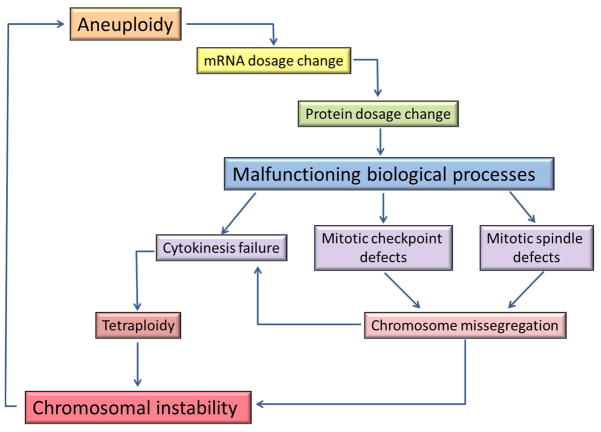What is meant by chromosomal instability ?How does having deleted or duplicated chromosomes cause this,and how would this apply to Klinefelters syndrome ?
1 Answer
Chromosomal instability is a change in karyotype of cells. This often co-exists with aneuploidy such as in Klinefelter's syndrome.
Explanation:
Chromosomal instability (CIN) is an important hallmark of cancer. CIN is the rate at which whole chromosomes or parts of chromosomes are lost or gained in cells. This can be studied within cell populations (cell-to-cell variation) or between cell populations.
Several types of CIN can be distinguished:
- clonal chromosome aberrations (CCA): these are recurring karyotypic alterations. There are short-lived transitional CCA's and late-stage stable CCA's.
- non-clonal chromosome aberrations (NCCA): these are randomly occuring alterations, previously considered insignificant or noise. NCCA's can be structural or numerical.
CIN should not be confused with genomic instability. Genomic instability includes CIN, but also other types of instability.
CIN is an important driver of cancer progression. The focus in research has long been on genes rather than chromosomes. Therfore, the exact mechanisms behind CIN are not yet clarified.
Underlying mechanisms can be put into two categories:
-
Category I: (molecular) mechanisms that are directly related to the chromosomal cycle(condensation, segregation), chromosome structure (integrity of telomeres, centrosomes) and repair mechanisms. These processes are influenced by many genes and pathways.
-
Category II mechanisms on a systemic rather than a molecular level. Factors that cause stress influence system dynamics. Such factors are infection, epigenetic alterations, physiological stress, toxins etc.
Aneuploidy is the presence of an abnormal number of chromosomes. Aneuploidy and CIN often co-exist. Aneuploidy can be a cause of CIN and the other way around.
Males with Klinefelter's syndrome have an extra X-chromosome. There is not much known yet about CIN in men with this syndrome.
The current idea is that CIN and aneuploidy are linked in a vicious cycle. So when a person already has a chromosomal aberration, as in Klinefelter's syndrome, it has a higher chance on accumulating other chromosomal aberrations leading to CIN.

The image above gives an overview of the processes that possibly cause this vicious cycle. The main mechanism is dose changes in protein and mRNA, leading to failure in cell cycle processes, finally causing chromosomal aberrations.

